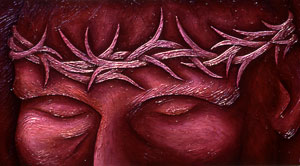 What is suffering? I
know the concept, feel empathy for the experiences I hear; yet
considering the crucifixion of Christ, I have difficulty grasping
the significance of the word. Here was a man who willfully
received torture and death in the place of others more deserving.
This was not an act of circumstance, but one of intent.
Suffering comes to many by chance and fate, but how many choose that
path? I think the sacrifice of Jesus, the coronation of our
king, is easily among the most difficult concepts of Christianity.
It is a hurdle that is often too tall to cross.
What is suffering? I
know the concept, feel empathy for the experiences I hear; yet
considering the crucifixion of Christ, I have difficulty grasping
the significance of the word. Here was a man who willfully
received torture and death in the place of others more deserving.
This was not an act of circumstance, but one of intent.
Suffering comes to many by chance and fate, but how many choose that
path? I think the sacrifice of Jesus, the coronation of our
king, is easily among the most difficult concepts of Christianity.
It is a hurdle that is often too tall to cross.
Early in 2004, I was
approached to do a commission that focused on the crown of thorns
given to Jesus. This was to be a large work, over six feet
wide and three feet tall; a painting to make an impact. The
support for this work was so wide that I had to paint it on the
floor. My easel was no match for such a hefty piece. In
many ways, neither was I.
As I knelt on the ground,
hunching over this massive canvas, I could not help but consider the
man who was coming out of the paint. Each scrape of the
palette knife gouged a smooth forehead and punctured it with thorns.
His tired face was pulled out of repeated scratches of texture.
Even the glazes themselves glowed red like raw flesh. It was a
strange combination of loving detail and vigorous affliction.
More than a few nights were spent awake and working on this piece,
as sleep failed me.
The crucifixion of Christ
is not all about violence, although it would seem so from this
description. Really, the beauty in this work is not in the
pain, but the love. The crown of thorns, placed to mock a
dying man; the torn skin and beaten brow; they all represent love.
Remembering that Jesus was not taken outside of His own choice and
willingness; the punishment was taken from others. He did this
for everyone; He did this for me.
